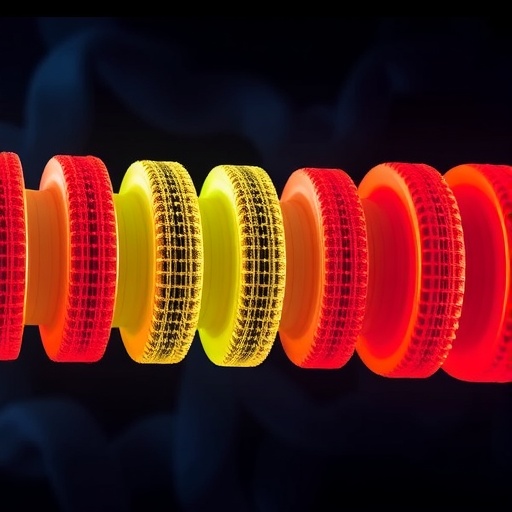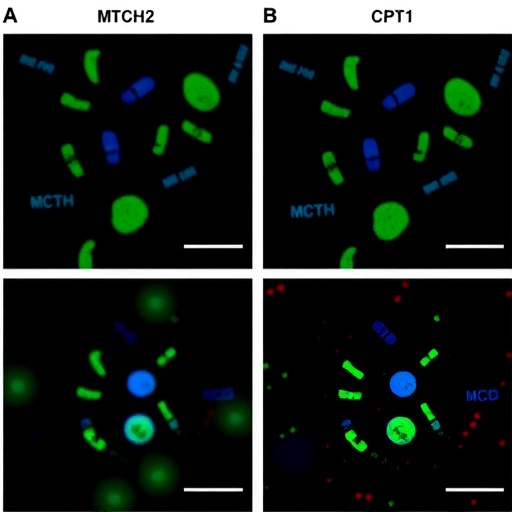In a groundbreaking advance that stands to deepen our understanding of cellular excitability, researchers have unveiled a physiologically-relevant intermediate state structure of a voltage-gated potassium channel, illuminating the intricate mechanisms that govern electrical signaling in cells. Voltage-gated potassium channels (Kv channels) are critical components of excitable membranes, responsible for repolarizing cells after action potentials and thus shaping electrophysiological responses in neurons, muscle cells, and many other excitable tissues. Despite decades of research, the transient intermediate conformations these channels adopt during gating have remained enigmatic, limiting the ability to fully grasp their functional dynamics and pharmacological modulation.
The recent work, published in Nature Communications by Kyriakis and colleagues, employs a cutting-edge combination of cryo-electron microscopy, electrophysiology, and computational modeling to capture and characterize an elusive intermediate conformation of the Kv channel. Unlike previous structures that represent either the fully open or closed states, this intermediate state reflects a physiologically relevant snapshot of the channel in transition. This discovery profoundly expands the molecular understanding of voltage sensing and gating mechanisms, offering a crucial missing piece in the puzzle of how electrical signals propagate and are finely controlled at the molecular level.
The voltage-gated potassium channel is composed of a tetrameric assembly forming a central pore that selectively conducts K+ ions, underpinning the ionic basis of membrane potential. Each subunit contains six transmembrane helices, with the S1–S4 segments forming the voltage-sensor domain (VSD) and the S5–S6 segments constituting the pore domain. Upon membrane depolarization, conformational changes in the VSD are transduced to the pore, prompting it to open and allow potassium efflux. The intricate choreography of these structural transitions has been challenging to capture experimentally due to their transient nature and rapid kinetics.
Kyriakis et al. overcame these barriers by stabilizing the channel in an intermediate gating state through strategic mutagenesis and voltage-clamp fluorometry, followed by high-resolution cryo-EM imaging. Their approach allowed visualization of the VSD in a partially activated conformation, uncoupled from the pore’s fully open or closed status. Structural analysis revealed that segments S4 exhibited partial outward movement relative to the membrane plane, while the pore domain adopted a conformation suggestive of a non-conducting but poised configuration.
This intermediate state sheds light on the finely tuned electromechanical coupling between the voltage sensor and the pore, suggesting a two-step gating mechanism rather than a simple binary transition. Such stepwise gating is likely essential for the channel’s high fidelity and kinetic precision, preventing errant ion flow and providing opportunities for modulation by cellular factors or drugs. The data also revealed key interactions between gating charges on S4 and negatively charged residues in the surrounding helices, stabilizing this intermediate conformation and underscoring the electrostatic intricacies driving the gating process.
Importantly, the discovery provides new insight into the potential pharmacological targeting of Kv channels. Many neurological disorders, cardiac arrhythmias, and other pathologies arise from channel dysfunction or aberrant gating behaviors. Understanding the structural basis of intermediate gating states opens avenues for the design of novel modulators that stabilize specific conformations, thus offering therapeutic precision that was previously unattainable. This structural framework suggests that allosteric sites accessible only during intermediate conformations might be exploited to develop drugs with reduced side effects by avoiding interference with fully open or closed states.
Beyond pharmacology, this finding enhances our fundamental comprehension of voltage sensing transduction, a highly conserved mechanism across diverse ion channel families. The ability to visualize the intermediate state bridges a critical knowledge gap between static structural snapshots and dynamic gating processes inferred from electrophysiology. This integrative view promises to refine computational models of membrane excitability, permitting simulations that more faithfully represent the kinetic and energetic landscape traversed during channel operation.
The study also carries implications for understanding how mutations associated with channelopathies affect gating. Certain disease-linked variants might preferentially destabilize intermediate states, skewing the balance of open and closed channel populations and thus altering cellular excitability. Structural insights into the intermediate conformations provide a template for interpreting how subtle sequence alterations translate into profound physiological consequences, offering a roadmap for precision medicine strategies targeting mutant channels.
Technically, the successful resolution of this intermediate state underscores the power of modern cryo-EM methodologies combined with voltage clamp approaches. By carefully controlling the ionic and voltage environment and employing mutants to trap conformations, the team navigated past the technical challenges that have historically limited visualization of fleeting channel states. This approach sets a new standard for structural biology studies of dynamic membrane proteins, suggesting that other elusive intermediate states in ion channels and transporters could soon be similarly unraveled.
Furthermore, the results provoke intriguing questions about the evolutionary optimization of voltage-gated channel gating. The observed stepwise conformational changes may reflect a finely honed balance between speed, order, and energy efficiency, crucial for the rapid signaling requirements of complex organisms. Future comparative studies of related channels from different species could elucidate how structural intermediates have adapted to distinct physiological demands.
Another compelling aspect is the potential for investigating allosteric modulation by auxiliary subunits or lipids that interact with Kv channels in native membranes. The intermediate state structure provides a scaffold to probe how these interacting partners influence gating transitions, adding layers of regulatory complexity that extend beyond the canonical pore and voltage sensor domains. This holistic view will be vital for understanding channel behavior in situ, where multiple factors converge to fine-tune electrical signaling.
As electrophysiology and structural biology increasingly converge, this work exemplifies the promise of an integrated approach to unravel dynamic molecular processes central to life. Capturing an intermediate gating state not only enriches the ion channel field but serves as a paradigm for studying conformational landscapes of other dynamic proteins critical to health and disease.
In conclusion, the elucidation of a physiologically relevant intermediate state structure of a voltage-gated potassium channel marks a seminal advance, providing unprecedented molecular insight into the gating mechanics that underpin electrical signaling. By bridging the gap between static structures and electrophysiological function, this study opens fresh avenues for hypothesis-driven drug design, disease mechanism exploration, and evolutionary biology. It redefines our understanding of one of the most fundamental biological nanomachines and sets a new trajectory for future research into the dynamic world of excitable membranes.
Subject of Research: Voltage-gated potassium channel gating mechanism and structure
Article Title: A physiologically-relevant intermediate state structure of a voltage-gated potassium channel
Article References:
Kyriakis, E., Sastre, D., Eldstrom, J. et al. A physiologically-relevant intermediate state structure of a voltage-gated potassium channel. Nat Commun 16, 8814 (2025). https://doi.org/10.1038/s41467-025-64060-3
Image Credits: AI Generated
Tags: cellular excitability mechanismscomputational modeling in neurosciencecryo-electron microscopy in structural biologyelectrical signaling in excitable tissueselectrophysiological responses in neuronsgating mechanisms of ion channelsmolecular dynamics of voltage sensingpharmacological modulation of potassium channelsphysiologically relevant intermediate statetetrameric assembly of Kv channelstransient conformations in ion channelsvoltage-gated potassium channels





